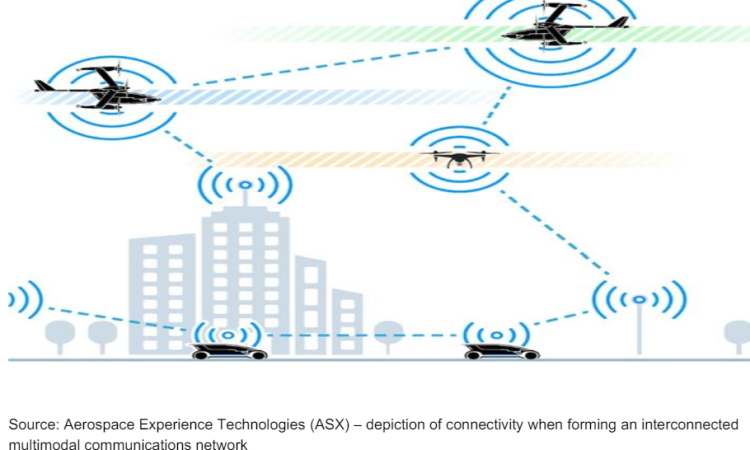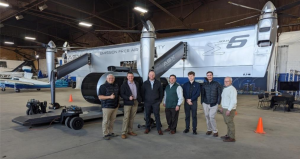In the United States, WSP has been working with Michigan to advance a communications framework for the state’s emerging AAM ecosystem. According to WSP Vice President of Aerial Innovation Paul Wheeler, in an interview on WSP website, the company has partnered with Michigan to explore the integration of short-range wireless technology to address the gaps between uncrewed aircraft systems (UAS). The following paragraphs are taken from the interview, reproduced with kind permission of WSP.
“Our primary objectives involve evaluating the efficacy of a short-range communications mesh in facilitating beyond visual line-of-sight UAS deployments—toward developing a robust communications framework,” said Paul Weaver. “Moreover, our goal is to utilize this technology to improve communication and integration between various transportation modes—including buses and trains—and AAM aircraft, contributing to the development of a more efficient and interconnected transportation system.”
An interconnected communications system will enable seamless coordination between these vehicles, supporting safe and efficient operations. It can help prevent collisions, manage traffic flow and allow more efficient operations between multiple transportation modes.
“A communications mesh for this scope encompasses a comprehensive network architecture that integrates Cooperative Intelligent Transportation Systems (C-ITS) frameworks and wireless technologies to facilitate seamless communication among various modes of transportation, including UAS and AAM Vehicles, as well as automated connected vehicles, trains, buses and other transit systems. This mesh is engineered to address short-range wireless communication scenarios, requiring a fusion of mission planning, cooperative behaviour and autonomous capabilities. latency data exchange between UAS, passenger air mobility vehicles, ground control stations, vertiports and other relevant entities can enable instant updates on travel times, vehicle locations, weather conditions and other critical information, allowing for timely decision-making and adjustments to flight plans.
“As AAM operations take hold in their full complexity, having an efficient traffic management system that can assist by providing advisories and communications will be essential. A sophisticated traffic management system will enable aircraft to receive and respond to traffic advisories, route changes and other instructions rapidly, contributing to a smooth and organized traffic flow. Additionally, there will be a need for advanced situational awareness due to the scale of operations. A communications network can facilitate enhanced situational awareness for both crewed and uncrewed vehicles.
“Pilots and operators can receive information about positions, intentions and status of other vehicles in the vicinity, reducing the risk of conflicts between operations. Another factor will be emergency response. In the event of emergencies, a robust communications network can provide quick and effective communication to facilitate rapid response and coordination. When incorporating the transportation system of the future, a necessity will be multimodal integration with existing infrastructure. A comprehensive communications network can facilitate smooth incorporation into established aviation and air traffic control systems. Moreover, this network can enhance travel times and operational efficiencies by linking various modes of transportation, mitigating congestion through effective coordination. As AAM and UAS operations evolve and expand, a robust communications network must allow for scalability and be adaptable to accommodate new technology and increased operations.”
“AAM systems will involve many components and technologies from different manufacturers, which may prove difficult when interoperability is needed. Additionally, bridging silos between vehicles that have traditionally been separate may also prove difficult. To help mitigate these risks, there should be a standard created for communications protocols and interfaces within the AAM ecosystem. Developing and implementing this standard would require collaboration among stakeholders toward forming a seamless communications mesh. Security and privacy will also need to be addressed to confirm adherence to data security protocols. Some solutions would be to require data encryption mechanisms to secure all V2X communication channels. Security protocols would also need to be updated frequently to address any emerging threats. Scalability may also prove to be a challenge as infrastructure needs grow to accommodate a growing and diverse number of vehicles.”
Project team members—from WSP, MDOT and ASX—in front of the advanced air mobility aircraft developed by ASX, WSP’s partner on the Michigan communications mesh project.
“One solution is to optimize V2X communications protocols for low latency and leverage edge computing to process critical data closer to the source, reducing round-trip times.
“Additionally, the evolving regulatory landscape must be considered to make it possible for the system to remain adaptable to changing requirements, aligning with legal standards. While current global regulations primarily impact flight operations rather than network hardware, there’s a risk that future regulations may mandate unforeseen minimum standards or components. The development of this communications network should inform these standards and hardware requirements for future iterations, to support scalability and compliance. In parallel with regulatory considerations, fostering workforce development in the AAM sector is essential.”
For the full text please visit:
https://www.wsp.com/en-gl/insights/developing-a-communications-framework-for-advanced-air-mobility?utm_source=linkedin&utm_medium=organic&utm_campaign=global_TI_aviation







